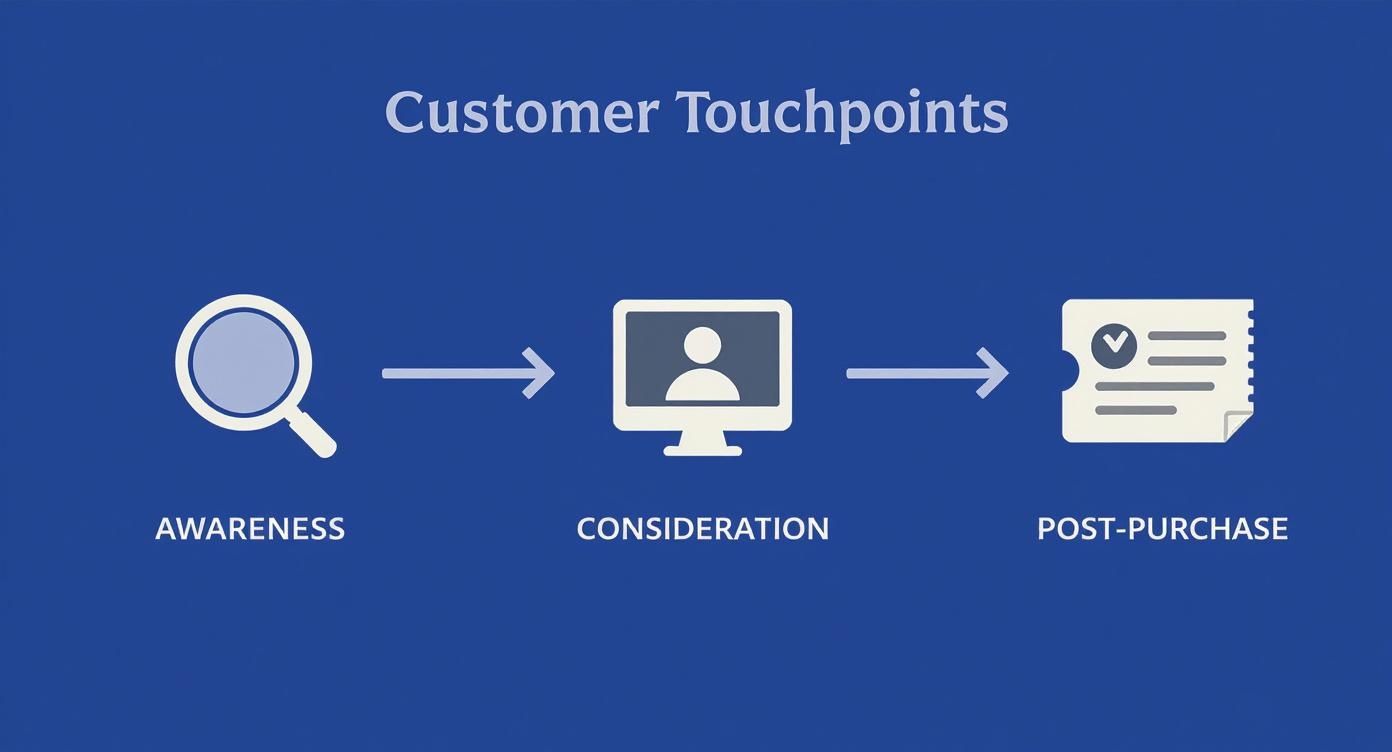B2B customer journey mapping is the process of creating a visual story of every interaction a business client has with your company—from their first touchpoint to post-purchase support and beyond. It transforms abstract data into a clear, chronological narrative of your customer's experience, capturing their actions, thoughts, and feelings at each stage. This strategic visualization is essential for identifying friction points and, more importantly, unlocking significant growth opportunities.
Why Journey Mapping Is Essential in B2B

The traditional, linear sales funnel is no longer sufficient for the modern B2B buying process. Today's landscape involves a complex web of independent digital research, multiple stakeholders, and high expectations for a seamless, personalized experience. Understanding this intricate path is not just a "nice-to-have"—it's a core strategic imperative for any business focused on growth.
Meeting the Self-Educated Buyer
Modern B2B buyers are researchers. They complete a significant portion of their evaluation process online long before engaging with a sales representative. This shift makes it critical to understand their digital footprint and provide them with the right information at the right time.
By 2025, B2B buyers are expected to conduct approximately 67% of their purchasing journey online. Tellingly, only about 17% of their time is spent in direct contact with potential suppliers. This reality underscores the immense value of optimizing every digital touchpoint to influence decisions early and effectively.
A well-crafted journey map allows you to pinpoint where these digital interactions occur, helping you deliver value long before a formal sales conversation begins.
A B2B customer journey map is your organization's shared compass. It ensures that every department—from marketing to sales to customer service—is navigating by the same stars, all centered around the customer's actual experience.
Before building a map, you need to understand its core components. Here is a breakdown of the essential elements.
Key Components of a B2B Journey Map
A quick overview of the essential building blocks you'll need to create a comprehensive and actionable B2B journey map.
Gathering these elements transforms a simple timeline into a strategic tool for uncovering insights and driving meaningful improvements.
Unifying Teams and Uncovering Opportunities
One of the most powerful outcomes of B2B customer journey mapping is the organizational alignment it fosters. When departments operate in silos, the customer experience becomes fragmented. A journey map compels everyone to see the bigger picture from the customer’s perspective.
This unified view helps your teams:
- Pinpoint Friction: Identify exactly where customers encounter issues, allowing you to address these pain points proactively.
- Align Messaging: Ensure consistent communication across all channels, from a LinkedIn ad to a sales demo.
- Uncover Revenue Gaps: Spot hidden opportunities for upselling, cross-selling, or creating new content that addresses unmet needs.
Ultimately, this process builds a significant competitive advantage. A deep understanding of your customer's reality enables informed, data-driven decisions that foster loyalty and drive sustainable growth. To achieve this, it's vital to establish strong B2B marketing and sales alignment from the outset.
Building Your Foundation with Research and Personas

An effective B2B customer journey map is grounded in reality, not internal assumptions. To create a map that accurately reflects the customer experience, you must build it on a solid foundation of data—a blend of quantitative metrics and qualitative human stories. This involves going beyond surface-level analytics to understand the why behind customer actions.
Begin by tapping into the knowledge within your company. Your sales, support, and product teams interact with customers daily. They hear the unfiltered feedback, common frustrations, and moments of delight that analytics reports cannot capture.
Schedule interviews with these internal experts. Ask about common questions, major objections, and the specific pain points that drive prospects to seek a solution. This internal intelligence provides a rapid and valuable framework for your map.
Uncovering Insights from Your Data
While anecdotal evidence is powerful, it must be supported by quantitative data. Your CRM is an excellent starting point. Analyzing this data helps you identify behavioral patterns, understand the commonalities among your best customers, and determine the typical sales cycle length.
Look for these key trends:
- Common Pathways: Which marketing channels or content pieces are most frequently associated with closed deals?
- Engagement Metrics: What is the average number of touchpoints an account has before converting?
- Drop-Off Points: At which stage do most prospects disengage?
This analysis reveals what is happening. When combined with qualitative feedback, you begin to understand why it’s happening, providing the complete picture needed for an accurate journey map.
A journey map built on assumptions is a work of fiction. A map built on a combination of qualitative interviews and quantitative data becomes a strategic tool for genuine business growth.
Crafting Realistic B2B Buyer Personas
With your research complete, it's time to translate it into dynamic buyer personas. In the B2B world, sales rarely involve a single individual. Instead, you're dealing with a buying committee composed of multiple stakeholders, each with their own motivations and challenges.
A comprehensive B2B journey map must account for these different roles. Your personas should represent the entire buying committee.
- The End-User: This individual will use your product or service daily. They are concerned with features, usability, and how it will simplify their job. Their primary question is, "Will this solve my immediate problem?"
- The Technical Buyer: This stakeholder, often an IT manager or engineer, focuses on integration, security, and compatibility with existing systems. They need to know, "Will this fit into our current tech stack without causing issues?"
- The Financial Decision-Maker: This person, such as a CFO or department head, controls the budget. They are focused on ROI, pricing, and contract terms, asking, "Is this a smart financial investment for our company?"
Each persona experiences the journey differently, consuming unique content and engaging at various points. For a detailed guide on this step, explore how to create buyer personas that truly resonate.
By developing distinct personas, you can map out parallel journeys that illustrate how each member navigates the process. This multi-layered perspective is what makes B2B customer journey mapping so effective, allowing you to tailor messaging and content to each key player's needs.
With research done and personas defined, the next step is to build the blueprint of your customer journey map. This involves a systematic inventory of every interaction a customer has with your company, known as touchpoints.
Think of touchpoints as the individual scenes that make up the story of the customer experience. A comprehensive B2B customer journey mapping exercise must account for all of them—from initial awareness through long-term loyalty. Overlooking key interactions will result in a distorted picture of reality.
Uncovering the Full Spectrum of Interactions
Many businesses make the mistake of mapping only the most obvious touchpoints, like a sales call or a website visit. However, valuable insights often lie in the less visible interactions that occur before, between, and after these major events. Your goal is to identify and chart them all.
The most effective way to organize this inventory is by using the classic stages of the B2B journey:
- Awareness: This is when prospects first discover your brand. Did they see a LinkedIn ad, read a guest post on an industry blog, or hear your company mentioned on a podcast?
- Consideration: At this stage, they are actively evaluating solutions, and touchpoints become more direct. This includes downloading a whitepaper, attending a webinar, reading customer reviews on third-party sites, or using a pricing calculator on your website.
- Decision: Interactions become highly focused. This may involve requesting a personalized demo, reviewing a detailed proposal, or negotiating contract terms with a sales representative.
It is crucial to look beyond the assets you own and control. A customer's journey is heavily influenced by external touchpoints like industry forums, analyst reports, or peer recommendations. Identifying these is key to understanding the forces shaping their decisions.
Charting the Post-Purchase Experience
The journey does not end when the contract is signed. For B2B companies, especially in SaaS and professional services, the post-purchase phase is where long-term value is either built or destroyed. Overlooking these touchpoints is a common and costly mistake.
Let's break down the interactions that define this critical period:
- Onboarding: This includes the entire welcome experience, from the initial kickoff call and software setup to user training sessions. A cumbersome onboarding process can damage a new relationship before it begins.
- Support: Every support ticket, live chat session, or call to a help desk is a critical moment. These touchpoints test your company's commitment to customer success.
- Ongoing Engagement: This encompasses quarterly business reviews, product update newsletters, and renewal conversations. These are opportunities to reinforce the value you provide and build a strong case for retention.
By meticulously charting both pre- and post-purchase touchpoints, you move from a narrow view of the sales cycle to a holistic understanding of the entire customer lifecycle. This is where you find the moments that truly define loyalty.
Consolidating this information requires data from multiple systems. This is where effective customer data integration solutions are essential. They help create a single, unified view of every touchpoint, connecting your marketing automation platform, CRM, and support ticketing system. This integration ensures your map is built on a complete and accurate foundation.
Bringing Your B2B Journey Map to Life
With your research and touchpoint inventory complete, it's time to translate that data into a clear, compelling visual story. This is where your B2B customer journey mapping effort transforms from raw information into a powerful strategic asset that your entire team can use.
The goal is not just a diagram but a narrative that tells the story of your customer's reality in a way that is both comprehensive and easily understandable. The right format is key to achieving this.
This infographic illustrates the typical flow, from a prospect’s initial awareness all the way through to post-purchase and advocacy.

Notice how interactions evolve over time. They begin broadly during discovery, become specific during evaluation, and then transition to ongoing support. Visualizing the journey this way makes it easier to allocate resources effectively.
Choosing the Right Map Format
There is no single "correct" way to format a journey map. The best choice depends on the complexity of your customer's path and your objectives. For a simple sales cycle, a basic timeline might suffice. However, B2B journeys are rarely simple.
For most B2B scenarios, a swimlane diagram is the most effective format. This layout allows you to track multiple streams of information simultaneously, providing a rich, multi-layered view of the customer experience.
A typical swimlane structure includes:
- Top Lane: Journey Stages (e.g., Awareness, Consideration, Decision, Onboarding)
- Persona Lane: Details of the specific buyer persona this map represents.
- Actions Lane: What the customer is physically doing (e.g., "Downloads whitepaper," "Attends webinar").
- Thoughts & Feelings Lane: Their internal monologue and emotional state (e.g., "Feeling overwhelmed," "Feeling confident").
- Pain Points Lane: Roadblocks or frustrations they encounter.
- Opportunities Lane: Ideas for how you can improve the experience.
This structure is powerful because it captures not only the what but also the why—the thoughts, feelings, and frustrations that define the customer's experience.
Plotting the Essential Information
With your format selected, populate it with the insights you've gathered. Plot specific data points for each stage of the journey, ensuring that every point is based on your research, not internal assumptions.
For each stage, focus on these key elements:
- Customer Actions: Be granular. Instead of a vague "Researches solutions," use specifics like "Reads G2 reviews" or "Compares feature lists on competitor websites."
- Customer Questions: Identify the questions on their minds at each point. Early on, it might be, "How do I solve this business problem?" Later, it could be, "Which vendor offers the best ROI?"
- Emotional Journey: Map their emotional state using a simple line graph or emoticons. Are they excited, confused, frustrated, or relieved? The emotional arc often reveals the most critical "moments of truth."
A common mistake is mapping only the touchpoints you own. An effective map must also include external factors—industry forums, third-party review sites, and peer recommendations—to provide a complete picture.
Selecting the Right Tools for the Job
The tool you choose to build your map can make a significant difference. Your decision should be based on your team's needs, budget, and the desired level of detail.
Tools generally fall into two categories:
- Collaborative Digital Whiteboards: Tools like Miro or Mural are excellent for initial brainstorming and workshops. They are flexible, intuitive, and ideal for capturing ideas quickly.
- Specialized Journey Mapping Software: Platforms such as TheyDo or UXPressia are designed specifically for this purpose. They offer structured templates, data integration, and features for ongoing management, making them ideal for creating a living document.
Many specialized tools also offer automation capabilities. As you identify friction points on your map, you can design automated workflows to improve the experience. To understand how this works in practice, read our guide on successful marketing automation implementation.
Ultimately, the best tool is the one your team will use consistently. Don't hesitate to start simple; a useful map in a basic tool is far more valuable than a complex one that goes unused.
Turning Your Map into a Strategic Action Plan
A beautifully designed journey map that sits unused is a waste of effort. The true value of B2B customer journey mapping lies in using the map to drive meaningful change. Now that you have a visual representation of the customer experience, it’s time to shift from observation to action.
This is where you analyze your map to identify "moments of truth"—the critical interactions that define a customer's perception of your brand. A positive experience at these touchpoints can create a loyal advocate, while a negative one can send them to a competitor.
From Insights to Impactful Priorities
Your completed journey map is a goldmine of insights, likely highlighting numerous areas for improvement. You may have a long list of friction points, content gaps, and communication breakdowns. The challenge is not finding problems, but deciding which ones to address first.
Attempting to fix everything at once is a recipe for failure. A structured approach to prioritization is needed. A simple yet effective method is the impact/effort matrix. This exercise helps you visually sort opportunities and build a strategic roadmap.
For each issue identified, ask two critical questions:
- Business Impact: How significantly will fixing this improve customer satisfaction, retention, or conversion rates?
- Resource Feasibility: Realistically, how much time, money, and manpower are required to implement a solution?
This exercise highlights "low-hanging fruit"—high-impact, low-effort fixes. Addressing these first delivers quick wins, builds momentum, and earns the credibility needed to tackle larger initiatives. It also helps you postpone low-impact, high-effort projects that would drain resources for minimal return.
Identifying Key Areas for Action
As you analyze your map, distinct patterns of opportunity will emerge. These typically fall into a few key categories, and organizing your action plan around them will keep your strategy focused.
- Friction Points: Where are customers getting stuck or frustrated? This could be a clunky checkout process, a slow sales response, or a jargon-filled landing page. These are often the most urgent fixes as they directly contribute to lost deals.
- Content Gaps: Are customers looking for information you don't provide? Your map might reveal that prospects are searching for comparison guides or ROI calculators during the consideration stage, but your website offers none. Filling these gaps adds value and moves prospects forward.
- Channel Misalignment: Is the experience inconsistent as customers move between channels? A promise made in a marketing email that isn't reflected in a sales call can erode trust. A unified message across all touchpoints is essential.
A common mistake is to focus only on fixing negative aspects. Your journey map also highlights what you're doing well. Identify these "moments of delight" and determine how to replicate that positive experience across the entire journey.
By systematically identifying and categorizing these issues, you can build a strong business case for necessary changes. The visual nature of a journey map is a persuasive tool for gaining leadership buy-in. Instead of presenting a list of problems, you can show them exactly where and why the customer experience is failing.
Aligning Your Organization for Change
Ultimately, a journey map is an alignment tool. It breaks down silos between marketing, sales, product, and service teams, focusing everyone on a shared view of the customer's reality. Effective maps highlight handoff points and friction, compelling the business to streamline processes and coordinate efforts. Companies using data-driven maps have seen up to 54% higher ROI from their marketing campaigns.
This organizational alignment is critical because the solutions you identify will almost always require cross-functional collaboration. Closing a content gap may require input from product, marketing, and sales. Improving onboarding requires coordination between sales, customer success, and support.
Your map becomes the common language that enables these teams to work together effectively, providing the context needed to see how individual roles impact the bigger picture. To track your progress, it’s essential to have a solid framework for customer experience measurement in place.
Got Questions About B2B Journey Mapping?
Even with a solid plan, practical questions often arise when implementing B2B customer journey mapping. Here are answers to some of the most common inquiries from teams ready to use their map to drive strategic change.
Consider this a quick field guide to help you navigate the process and maximize the value of your efforts.
How Often Should We Update Our B2B Journey Map?
It’s tempting to treat a journey map as a one-time project. This is a significant mistake. A map's value lies in its relevance, so it must be a living document that evolves with your business and customers.
As a general rule, we recommend a full review and refresh at least once a year. More importantly, you should revisit the map whenever a major business event occurs.
Key triggers for an update include:
- Launching a new product or service: This introduces new touchpoints and customer paths that need to be mapped.
- Entering a new market: Different audiences have unique needs and decision-making criteria that will alter the journey.
- Seeing major shifts in buyer behavior: If your analytics show sudden changes in how people find you or what content they engage with, your map must reflect this new reality.
Keeping your map current ensures it remains a reliable compass for strategic decisions.
What’s the Biggest Mistake to Avoid?
The most common pitfall is creating a map based solely on internal assumptions about the customer journey. This "inside-out" approach results in a map of your internal processes or wishful thinking, not the customer's actual experience.
This mistake creates a fictional map. It may look impressive, but it won't uncover real insights because it isn't grounded in your customers' thoughts, feelings, and actions.
The most powerful and actionable journey maps are always built "outside-in." They are grounded in real customer interviews, authentic user feedback, and hard behavioral data. Without this customer-centric foundation, you're just mapping your own organizational chart.
To avoid this, ensure that qualitative customer research—real conversations with real buyers—is the foundation of your mapping process from the start.
Can a Small Business Create a Valuable Journey Map?
Absolutely. An impactful journey map is not about a large budget or sophisticated enterprise software. Small businesses often have an advantage because they are closer to their customers and can gather rich, qualitative insights more easily.
You don't need a massive, months-long project to begin. The value of a journey map comes from the authenticity of its insights, not the cost of the tools used.
Here’s a lean approach for small businesses:
- Conduct a few in-depth customer interviews: You can identify significant patterns from just five to eight thorough conversations.
- Send out simple surveys: Use free or low-cost tools to gather feedback on specific parts of the experience.
- Talk to your team: Your sales and customer support staff are a goldmine of information on customer frustrations and successes.
A simple, accurate map built from this focused, human-centered research is far more valuable than a complex, data-heavy map that misses the human story.
At Twelverays, we specialize in transforming complex customer data into clear, actionable strategies that drive measurable growth. If you’re ready to move beyond assumptions and build a B2B customer journey map that truly aligns your business with your buyers, we can help. Discover our data-driven marketing and CRM solutions at https://twelverays.agency.





